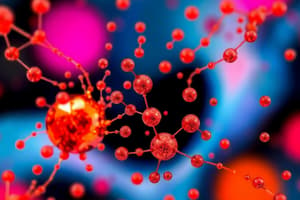Podcast
Questions and Answers
Explain the top-down approach to nanoparticle synthesis mentioned in the text.
Explain the top-down approach to nanoparticle synthesis mentioned in the text.
The top-down approach involves techniques such as mechanical alloying, nanolithography, electron-beam lithography, x-ray lithography, soft lithography, and severe plastic deformation to create nanoparticles from larger materials.
Why are nanoparticles not energetically favorable, according to the text?
Why are nanoparticles not energetically favorable, according to the text?
Nanoparticles are not energetically favorable and therefore their properties have been exploited by embedding them in polymer or metal or ceramic matrices to make them thermodynamically stable nanocomposites.
What are some examples of the bottom-up approach to nanoparticle synthesis described in the text?
What are some examples of the bottom-up approach to nanoparticle synthesis described in the text?
Examples include synthesis of nanoparticles by physical vapor deposition, chemical vapor deposition, colloidal route, green chemistry route, and sol-gel method, where atoms or molecules are built up layer by layer.
How are the properties of nanoparticles utilized to make them thermodynamically stable, as mentioned in the text?
How are the properties of nanoparticles utilized to make them thermodynamically stable, as mentioned in the text?
Flashcards are hidden until you start studying
Study Notes
Nanoparticle Synthesis Approaches
- The top-down approach to nanoparticle synthesis involves breaking down bulk materials into smaller nanoparticles, often using mechanical or physical methods.
Energetic Favorability of Nanoparticles
- Nanoparticles are not energetically favorable due to their high surface energy, which makes them unstable and prone to aggregation.
Bottom-up Approach to Nanoparticle Synthesis
- The bottom-up approach involves building up nanoparticles from individual atoms or molecules, often using chemical reactions or biological systems.
- Examples of the bottom-up approach include sol-gel processing, microemulsion methods, and biomimetic synthesis.
Thermodynamic Stability of Nanoparticles
- The properties of nanoparticles can be utilized to make them thermodynamically stable, such as by modifying their surface chemistry or using ligands to stabilize the particles.
- This stability is achieved by reducing the surface energy of the nanoparticles, allowing them to persist in a stable state.
Studying That Suits You
Use AI to generate personalized quizzes and flashcards to suit your learning preferences.




